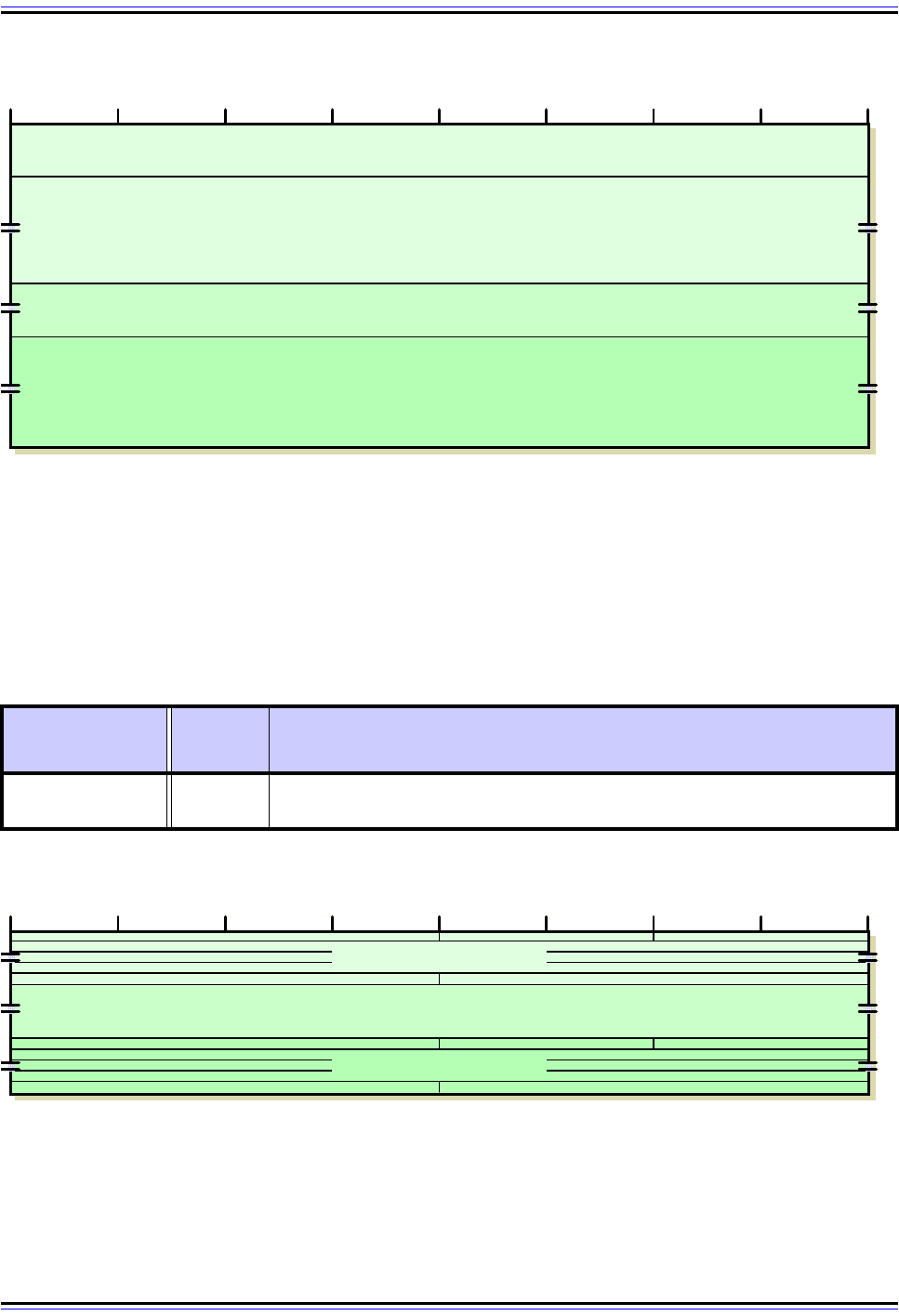Charles M. Kozierok The TCP-IP Guide
Подождите немного. Документ загружается.


The TCP/IP Guide - Version 3.0 (Contents) ` 751 _ © 2001-2005 Charles M. Kozierok. All Rights Reserved.
Flags 1
DD Sequence
Number
4
DD Sequence Number: Used to number a sequence of Database
Description messages so they are kept in order.
LSA Headers Variable
LSA Headers: Contains link-state advertisement headers, which carry
information about the LSDB. See near the end of the topic for more infor-
mation on LSAs.
Table 129: OSPF Database Description Message Format (Page 2 of 2)
Field Name
Size
(bytes)
Description
Fl
ags:
S
pec
i
a
l
fl
ags use
d
t
o
i
n
di
ca
t
e
i
n
f
orma
ti
on a
b
ou
t
th
e exc
h
ange o
f
Database Description messages:
Subfield
Name
Size
(bytes)
Description
Reserved
5/8
(5 bits)
Reserved: Sent and received as zero.
I
1/8
(1 bit)
I-Bit: Set to 1 to indicate that this is the first
(“initial”) in a sequence of Database Description
messages.
M
1/8
(1 bit)
M-Bit: Set to 1 to indicate that “more” Database
Description messages follow this one.
MS
1/8
(1 bit)
MS-Bit: Set to 1 if the router sending this message
is the master in the communication, or 0 if it is the
slave.

The TCP/IP Guide - Version 3.0 (Contents) ` 752 _ © 2001-2005 Charles M. Kozierok. All Rights Reserved.
Link State Request Message Format
These messages have a Type value of 3 in the header. Following the header comes one or
more sets of three fields that each identify a link state advertisement (LSA) for which the
router is requesting an update, as shown in Figure 187. Each LSA identification has the
format described in Table 130.
Figure 186: OSPF Database Description Message Format
Table 130: OSPF Link State Request Message Format
Field Name
Size
(bytes)
Description
LS Type 4 Link State Type: The type of link state advertisement (LSA) being sought.
Link State ID 4
Link State ID: The identifier of the LSA, usually the IP address of either the
router or network linked.
Advertising
Router
4
Advertising Router: The ID of the router that created the LSA whose
update is being sought.
Interface MTU Options Flags
DD Sequence Number
4 8 12 16 20 24 28 320
...
LSA Header #1
480
Reserved
Initial
Bit
(I)
Mor e
Bit
(M)
Mas ter /
Slave
Bit
(MS)
LSA Header #N

The TCP/IP Guide - Version 3.0 (Contents) ` 753 _ © 2001-2005 Charles M. Kozierok. All Rights Reserved.
Link State Update Message Format
These messages have a Type value of 4 in the header, and the fields illustrated in Table
131 and Figure 188.
Figure 187: OSPF Link State Request Message Format
Table 131: OSPF Link State Update Message Format
Field Name
Size
(bytes)
Description
# LSAs 4
Number of LSAs: The number of link-state advertisements included in this
message.
LSAs Variable LSAs: One or more link-state advertisements. See below for more details.
Link State Type
Link State ID
Advertising Router
4 8 12 16 20 24 28 320
...
Link State Type / Link State ID / Advertising Router #2
LSA Identification #1
Link State Type / Link State ID / Advertising Router #N

The TCP/IP Guide - Version 3.0 (Contents) ` 754 _ © 2001-2005 Charles M. Kozierok. All Rights Reserved.
Link State Acknowledgment Message Format
These messages have a Type value of 5 in the header. They then contain a list of LSA
headers corresponding to the LSAs being acknowledged, as shown in Table 132 and Figure
189.
Figure 188: OSPF Link State Update Message Format
Table 132: OSPF Link State Acknowledgment Message Format
Field Name
Size
(bytes)
Description
LSA Headers Variable
LSA Headers: Contains link-state advertisement headers, to identify the
LSAs acknowledged.
Figure 189: OSPF Link State Acknowledgment Message Format
Number of Link State Advertisements
Link State Advertisement #1
Link State Advertisement #N
4 8 12 16 20 24 28 320
...
4 8 12 16 20 24 28 320
...
LSA Header #1
LSA Header #N

The TCP/IP Guide - Version 3.0 (Contents) ` 755 _ © 2001-2005 Charles M. Kozierok. All Rights Reserved.
Link State Advertisements (LSAs) and the LSA Header Format
As we saw above, several of the message types include link state advertisements (LSAs),
which are the fields that actually carry topological information about the LSDB. There are
several types of LSAs, which are used to convey information about different types of links.
Like the OSPF messages themselves, each LSA has a common header with 20 bytes, and
then a number of additional fields that describe the link.
LSA Header
The LSA header contains sufficient information to identify the link. It uses the subfield
structure in Table 133 and Figure 190.
Table 133: OSPF Link State Advertisement Header Format
Subfield Name
Size
(bytes)
Description
LS Age 2 LS Age: The number of seconds elapsed since the LSA was created.
Options 1
Options: Indicates which of several optional OSPF capabilities the router
supports.
LS Type 1
Link State ID 4
Link State ID: Identifies the link. This usually is the IP address of either the
router or the network the link represents.
Advertising
Router
4 Advertising Router: The ID of the router originating the LSA.
LS Sequence
Number
4
LS Sequence Number: A sequence number used to detect old or
duplicate LSAs.
LS Checksum 2 LS Checksum: A checksum of the LSA, for data corruption protection.
Length 2 Length: The length of the LSA, including the 20 bytes of the header.
LS Type: Indicates the type of link this LSA describes:
Value Link Type Description
1 Router-LSA Link to a router
2 Network-LSA Link to a network
3
Summary-LSA (IP
Network)
When areas are used, summary infor-
mation generated about a network.
4
Summary-LSA
(ASBR)
When areas are used, summary infor-
mation about a link to an AS boundary
router.
5 AS-External-LSA
An external link outside the autonomous
system.

The TCP/IP Guide - Version 3.0 (Contents) ` 756 _ © 2001-2005 Charles M. Kozierok. All Rights Reserved.
LSA Body
Following the LSA header comes the body of the LSA, the specific fields of which depend
on the value of the LS Type field. It would take several more pages to describe all these
subfields, and I already probably went overboard in describing each message type, so I will
refer you to Appendix A of RFC 2328 if you want all the details. By way of quick summary:
☯ For normal links to a router, the LSA includes an identification of the router and the
metric to reach it, as well as details about the router such as whether it is a boundary
or area border router.
☯ LSAs for networks include a subnet mask and information about other routers on the
network.
☯ Summary LSAs include a metric and a summarized address, as well as a subnet
mask.
☯ External LSAs include a number of additional fields to allow the external router to be
communicated.
Figure 190: OSPF Link State Advertisement Header Format
LS Age Options LS Type
Link State ID
Advertising Router
LS Sequence Number
LS Checksum Length
4 8 12 16 20 24 28 320

The TCP/IP Guide - Version 3.0 (Contents) ` 757 _ © 2001-2005 Charles M. Kozierok. All Rights Reserved.
Other Interior Routing Protocols
The Routing Information Protocol (RIP) and Open Shortest Path First (OSPF) are the two
most well-known interior routing protocols used in the TCP/IP suite, and for this reason I
have described each in considerable detail. In addition to these, there are several other
TCP/IP interior routing protocols that fall into one of two categories. Some are either
protocols that are no longer used today but are interesting from a historical perspective, and
others are proprietary alternates to RIP and OSPF that you may encounter today in the
networking world but perhaps not as often.
In this section, I provide a brief description of four additional TCP/IP interior routing
protocols. I begin with a look at two obsolete protocols that played an important role in the
early Internet: the Gateway-to-Gateway Protocol (GGP) and the HELLO Protocol. I then
describe two interior routing protocols developed by Cisco Systems, which are sometimes
seen in the industry today as alternatives to RIP and OSPF: the Interior Gateway Routing
Protocol (IGRP) and the Enhanced Interior Gateway Routing Protocol (EIGRP).
Background Information: In some cases in this section, I make comparisons to
RIP and OSPF as appropriate, to show where these protocols are similar to or
differ from the “big two”. You may wish to have some familiarity with RIP and OSPF
before continuing here.
TCP/IP Gateway-to-Gateway Protocol (GGP)
In the overview topic on key routing protocol concepts, I described the evolution of TCP/IP
routing architectures. The modern Internet is based on the concept of independent auton-
omous systems (ASes) that run interior routing protocols within them, and exterior routing
protocols between them. The early Internet, however, was somewhat simpler; it consisted
of a relatively small number of core routers that carried detailed information about the
Internet as a whole, and non-core routers located around the core that knew only partial
information.
These core routers used a special routing protocol to communicate called the Gateway-To-
Gateway Protocol (GGP). GGP was originally developed in the early 1980s by Bolt,
Beranek and Newman (BBN) one of the pioneers of the Internet and TCP/IP. It was
documented in RFC 823, THE DARPA INTERNET GATEWAY
, published September 1982.
This protocol is now obsolete, but it played an important role in the early Internet, and also
introduced certain concepts that were used in routing protocols developed years later. This
makes knowing a little bit about it worthwhile.
Overview of Operation
GGP is similar in general operation to the Routing Information Protocol (RIP) in that it uses
a distance-vector algorithm to determine the best routes between devices. Like RIP, the
metric is a simple hop count, so GGP will select a route with the shortest number of hops.

The TCP/IP Guide - Version 3.0 (Contents) ` 758 _ © 2001-2005 Charles M. Kozierok. All Rights Reserved.
While we have seen in our discussion of RIP that hop count is not always the best metric of
cost for a router, it was actually a pretty good method of route determination back then. This
is because the early Internet used both computers and links that would be considered
glacially slow by today's standards, making each hop fairly “expensive” compared to
modern routing.
A router using GGP initially starts out in a null state, assuming that all links to other routers
and local networks are down. It then tests the status of its local networks by seeing if it can
send and receive messages on the network. Every 15 seconds, the router sends a GGP
Echo message to each of its neighbors. If the neighbor receives the message, it responds
with a GGP Echo Reply message. The router sending the Echo messages considers the
neighbor up if it receives back replies to a certain percentage of messages, defaulting to
50%.
Note: These messages serve a similar function to ICMPv4 Echo and Echo Reply
messages, but are not the same.
Actual routing information is communicated by sending GGP Routing Update messages.
These are similar in nature to RIP Response messages used in RIP. Each Routing Update
message contains the information in the sending router's routing table, which specifies
which networks the router can reach and at what cost (in hops) for each.
Each router receiving a Routing Update message knows that since it can reach the router
that sent the update, it can also reach all of those router's reachable networks at the cost of
an additional hop. It uses the information to update its own internal tables of destinations
and metrics. It then sends out its own Routing Update on its own attached networks, to
propagate the information learned from other routers on its own networks. This process
continues until eventually, routes to all GGP routers spreads across the internetwork, just
as they do in RIP.
Propagation of Routing Table Information
One interesting difference between GGP and RIP is that in GGP, networks and costs aren't
sent in pairs. Instead, a GGP router sends its routing table in groups. If it has three networks
it can reach at a cost of 1 it sends those in a group with distance value 1, then if it has a few
at a cost of 2 it sends those in a group with distance value 2, and so on. Another difference
is that GGP Routing Update messages are acknowledged. Each Routing Update message
is sent with a sequence number, which is used to ensure that out-of-date information is not
propagated. If the Routing Update is received and has a new sequence number (indicating
that it is recent information), the router processing it sends back a GGP Acknowledgment
message back to the originator. If the sequence number indicates the message is stale, a
Negative Acknowledgment is sent instead and the message discarded.

The TCP/IP Guide - Version 3.0 (Contents) ` 759 _ © 2001-2005 Charles M. Kozierok. All Rights Reserved.
As a distance-vector algorithm using hop count as a metric, GGP shared most of the same
pros and cons as RIP. It had simplicity on its side, but had various problems such as slow
convergence and issues such as the “counting to infinity” problem. GGP was a much more
rudimentary protocol than RIP, however, and did not include many of the features included
in RIP to handle such issues, such as split horizon. GGP was also limited to unsubnetted
classful networks, due to its age.
Current Role in TCP/IP
When Internet architecture moved to the use of autonomous systems, GGP was obsoleted.
While it was an important part of TCP/IP history, it is today not formally considered a part of
the TCP/IP protocol suite.
Key Concept: The Gateway-to-Gateway Protocol (GGP) was used to communicate
route information between core routers on the early Internet. It is a distance-vector
protocol that operates in a manner very similar to RIP. Each router periodically sends
out its routing table to neighboring routers, so each router can learn the cost, in hops, to
reach every network in the autonomous system. GGP is now considered a historical
protocol and is no longer part of TCP/IP.
The HELLO Protocol (HELLO)
The TCP/IP Internet as we know it today evolved over the course of decades. It began as
an experimental research project started by the United States Defense Advanced Research
Projects Agency (DARPA or ARPA), called the ARPAnet. The ARPAnet eventually grew
through the addition of other networks, such as the important NSFnet developed by the
National Science Foundation (NSF). The NSFnet backbone grew over the course of many
years and was instrumental to the eventual creation of the modern Internet.
The original NSFnet backbone consisted of six Digital Equipment Corporation (DEC,
absorbed by Compaq years ago) LSI-11 computers located across the United States.
These computers ran special software colloquially called “fuzzball” that enabled them to
function as routers. These “fuzzball routers” connected various networks to the NSFnet and
the ARPAnet.
The six NSFnet routers worked as an autonomous system (AS) and like any AS, used an
interior routing protocol to exchange routing information. The routing protocol used in these
early routers was called the HELLO protocol. It was developed in the early 1980s and
documented in RFC 891, DCN Local-Network Protocols
, published December 1983. The
name “HELLO” is capitalized, but is not an acronym; it simply refers to the word hello, since
the protocol uses messages that are sort of analogous to the routers talking to each other.

The TCP/IP Guide - Version 3.0 (Contents) ` 760 _ © 2001-2005 Charles M. Kozierok. All Rights Reserved.
Note: The Open Shortest Path First (OSPF) routing protocol has a message type
called Hello. The use of these messages is sometimes referred to as “the Hello
Protocol”. OSPF is not directly related to the HELLO protocol described in this
section, other than both protocols being used for routing in an AS. It is possible OSPF
borrowed the name Hello from the HELLO protocol but I can't find anything definitive on that
subject.
Overview of Operation
The HELLO protocol uses a distance-vector algorithm, like the Routing Information Protocol
(RIP) and the Gateway-to-Gateway Protocol (GGP). What's interesting about it, however, is
that unlike RIP and GGP, HELLO does not use hop count as a metric. Instead, it attempts
to select the best route by assessing network delays and choosing the path with the
shortest delay.
One of the key jobs of routers using HELLO is to compute the time delay to send and
receive datagrams to and from its neighbors. On a regular basis, routers exchange HELLO
messages that contain clock and timestamp information. By comparing the clock value and
timestamp in the message to its own clock using a special algorithm, a receiving device can
compute an estimate for the amount of time it takes to send a datagram over the link.
Like RIP and GGP, HELLO messages also contain routing information in the form of a set of
destinations that the sending router is able to reach and a metric for each. However in this
case, the metric is an estimate of the round-trip delay cost for each destination. This infor-
mation is added to the computed round-trip delay time for the link over which the message
was received, and used to update the receiving router's own routing table.
This seems a bit confusing, but is really similar to the way a hop-count distance-vector
protocol like RIP works. Router A using RIP receiving an RIP Response message from
Router B knows it can reach every destination Router B can, but at a cost of one extra hop
(the hop to go from Router A to Router B). Similarly, router A receiving a HELLO message
from Router B knows it can reach every destination that Router B can, but at an additional
approximate cost of the computed delay for the link between Router A and Router B.
Issues with Using Delay as a Metric
In theory, using delay calculations should result in more efficient route selection than simply
using hop count, but at the cost of more complexity than a hop-count algorithm. This makes
HELLO very interesting indeed, especially for a protocol that is over 20 years old. However,
since the latency of a link is often unrelated to its bandwidth, using time delay as a link
metric may lead to spurious results.
